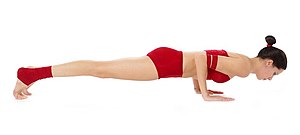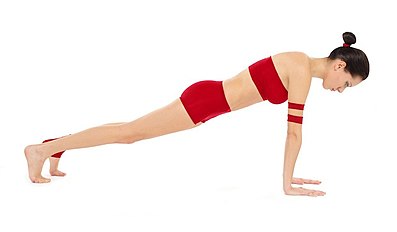Chaturanga Dandasana

Chaturanga Dandasana (
Etymology and origins
The name comes from the
The pose is unknown in
Description
In Chaturanga Dandasana the hands and feet are on the floor, supporting the body, which is parallel to and lowered toward, but not touching, the floor. It looks much like a push-up, but with the hands quite low (just above the pelvis), and the elbows kept in along the sides of the body.[4][5][6]
In
In yoga practice without vinyasas, the posture is simply held for a period of time (for instance, 30 seconds) with continuous breathing.[4]
Variations
Beginners can practise with the knees on the floor, or keeping the arms straight (in Kumbhakasana, also called Phalakasana or High Plank), before attempting the full pose. High Plank too is used in some forms of the Sun Salutation.[9]
Purvottanasana, Reverse Plank, or Upward Plank, has the back straight but the front of the body facing upwards, the arms outstretched down to the floor, the fingers pointing towards the feet.[10]
-
Variation with straight arms (Kumbhakasana, Phalakasana, or High Plank)
-
Purvottanasana, Reverse Plank
See also
- Dolphin Pose- a preparation for Pincha Mayurasana
- List of asanas
- Plank (exercise)
- Vasishtasana- side plank pose
References
- ^ "Yoga Journal - Four-Limbed Staff Pose". Retrieved 2011-04-09.
- ISBN 978-81-7041-293-9.
- ]
- ^ a b Iyengar 2005, p. 54-55.
- ^ Active Interest Media (1984). Yoga Journal. Active Interest Media. p. 19.
- ^ Kaminoff 2007, p. 183.
- ^ "Surya Namaskara A - Sun Salutation". Ashtanga Yoga. Archived from the original on 2012-03-11. Retrieved 2012-03-17.
- ASIN B000BFHDY0.
- ^ Hughes, Aimee. "Sun Salutation A Versus Sun Salutation B: The Difference You Should Know". Yogapedia.
- ^ "Reverse Plank or Upward Plank Pose". Yoga Journal. 28 October 2021. Retrieved 31 July 2022.
Sources
- ISBN 978-81-7223-606-9.
- ISBN 978-0-7360-6278-7.




